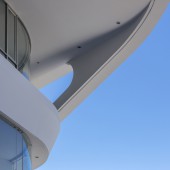GAIA Mixed-Use Building by Leppanen Anker Arquitectos |
Home > Winners > #52209 |
 |
|
||||
| DESIGN DETAILS | |||||
| DESIGN NAME: GAIA PRIMARY FUNCTION: Mixed-Use Building INSPIRATION: The poetics of form created by urban influences. Using sculptural techniques as a mechanism for blending urban fabric and architecture. The play between form and structure and the newly found, unconventional relationship between the two. The parametric/ iterative digital process that allows for multiple solutions to predetermined problems. Integration of efficiency into sculptural methods of design. UNIQUE PROPERTIES / PROJECT DESCRIPTION: Gaia is located near a newly proposed government building that incorporates a metro stop, a large shopping center, and the city's most important urban park. The mixed-use building with its sculptural movement acts as a creative attractor for inhabitants of the offices as well as the residential spaces. This requires a modified synergy between city and building. The varied programming actively engages the local fabric throughout the day, becoming a catalyst for what will inevitably soon be a hotspot. OPERATION / FLOW / INTERACTION: In the search for spatial wealth, facade elements were eliminated using a design concept that removes strategic corners. The characteristic corners generate double and triple height spaces and provide shade to protect from the hot Andean sun. The subtraction of areas was influenced by the surrounding urban elements. Vehicular traffic, pedestrians, wind, and sun intensity affected the depth of the voids, creating a play of movement within the building. Panoramic visual connections with the city activate these traditionally dead areas with other social programs. PROJECT DURATION AND LOCATION: The design process started in 2013. Construction started in September 2014 and was completed in September 2016. The building is located in Quito, Ecuador. FITS BEST INTO CATEGORY: Architecture, Building and Structure Design |
PRODUCTION / REALIZATION TECHNOLOGY: The structure combines concrete and steel and GFRC panels wrap the whole facade. The close relation between analog mold making and a parametric digital model proved key to the facade’s success. The facade incorporates a repeating patterning system allowing greater efficiency in fabrication costs and production times. A simple rigid steel structure is integrated into the GFRC panels. This system also includes adjustable connections to ease panel alignment and make up for inconsistencies in the construction process. The design of the panels allows their use as balcony handrails. SPECIFICATIONS / TECHNICAL PROPERTIES: The dimensions are 31 m x 30 m x 59 m. The total floor area is 15,000 m2 distributed over 14 stories. 59 apartments (50 m2 - 150 m2), 60 office spaces (44 m2 - 113 m2). Spa area, gym, cinema. TAGS: GAIA, QUITO, ECUADOR, GFRC, MIXED USE, ARCHITECTURE, PARAMETRIC RESEARCH ABSTRACT: - CHALLENGE: Gaia represents a giant step in the advancement of construction possibilities for Ecuador. This was the first time GFRC panels were used in this country, generating technological progress and new industry. As this fabrication technique is new here, it was challenging to find a contractor who could adequately fulfill our technical specifications. The facade incorporates a repeating patterning system allowing greater efficiency in fabrication costs and production time. The building footprint is a perfect square, also a key factor in the conceptualizing of the repeatable pattern. ADDED DATE: 2016-12-18 00:33:26 TEAM MEMBERS (6) : Gabriela Anker, Aaron Leppanen, Sofía Chávez, Caroline Dieden, Alberto Játiva and Tommy Schwarzkopf IMAGE CREDITS: Sebastián Crespo |
||||
| Visit the following page to learn more: http://www.laarquitectos.com | |||||
| AWARD DETAILS | |
 |
Gaia Mixed-Use Building by Leppanen Anker Arquitectos is Winner in Architecture, Building and Structure Design Category, 2016 - 2017.· Read the interview with designer Leppanen Anker Arquitectos for design GAIA here.· Press Members: Login or Register to request an exclusive interview with Leppanen Anker Arquitectos. · Click here to register inorder to view the profile and other works by Leppanen Anker Arquitectos. |
| SOCIAL |
| + Add to Likes / Favorites | Send to My Email | Comment | Testimonials | View Press-Release | Press Kit | Translations |
Did you like Leppanen Anker Arquitectos' Architecture Design?
You will most likely enjoy other award winning architecture design as well.
Click here to view more Award Winning Architecture Design.








